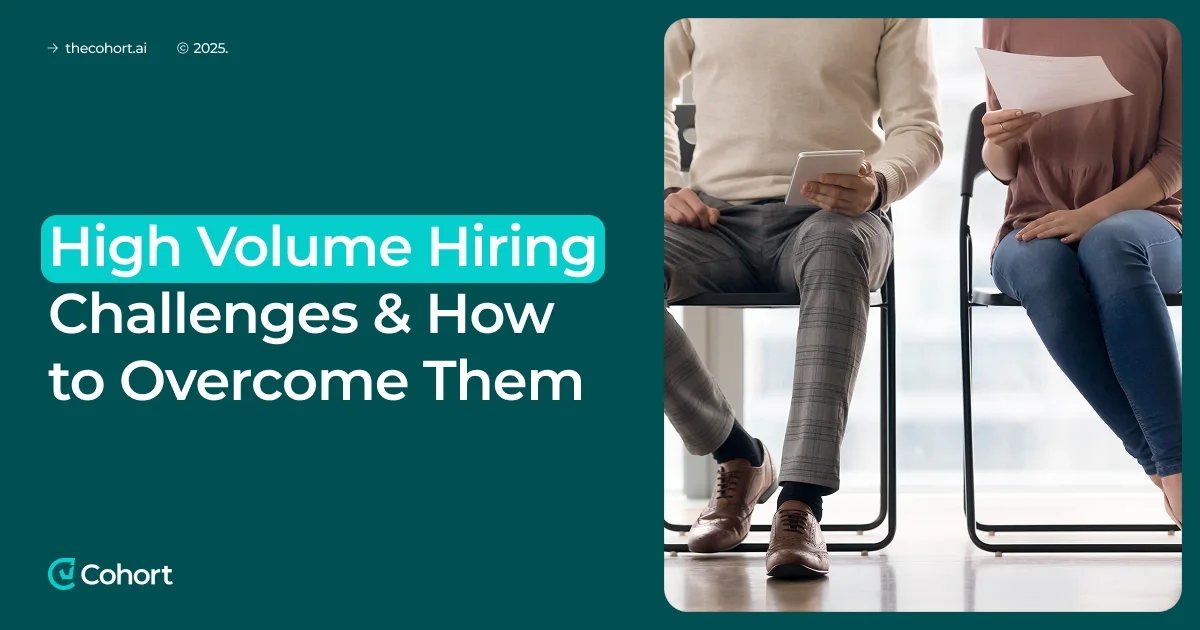Are you planning to hire a large number of new employees in the coming months?
It’s an exciting milestone for any growing business, marking a time of new energy, fresh talent, and big opportunities ahead.
However, while high-volume hiring sounds like a great step forward, it often brings unexpected challenges that can slow you down or affect the quality of your hires.
In this article, we’ll explore the 5 most common high-volume hiring challenges and share practical strategies to help you overcome them with confidence.
Key Takeaways
- Attracting qualified candidates requires strong employer branding
Build a positive, authentic employer brand that highlights culture, growth opportunities, and inclusion. Companies with strong brands receive twice as many quality applications and attract candidates who align with their mission.
- Automation is critical for managing application volume
High-volume hiring can overwhelm recruiters without the right tools. Using an ATS, automated screening, and smart scheduling systems can cut hiring cycles by up to 60% while keeping focus on top candidates.
- Strategic planning drives high-volume hiring success
Filling hundreds of roles quickly demands forecasting, talent pipelines, and technology-driven workflows. Streamlined processes and hiring events help companies meet tight deadlines without sacrificing quality.
- Consistency ensures quality and fairness at scale
Structured interviews, skills-based assessments, and data-backed hiring decisions reduce bias and improve the accuracy of hires, ensuring large-scale recruitment doesn’t lower standards.
- AI-driven recruiting tools like Cohort AI make high-volume hiring faster and smarter
Cohort AI automates sourcing, screening, and engagement using generative AI. By identifying top talent based on real skills, personalizing outreach, and cutting time-to-hire by up to 40%, it helps teams scale efficiently without losing the human touch.
What is high volume hiring?
High-volume hiring is the process of recruiting and onboarding a large number of employees within a short period of time. It typically involves filling multiple similar positions simultaneously. For example, staffing a new facility, preparing for a busy season, or expanding a large workforce quickly.
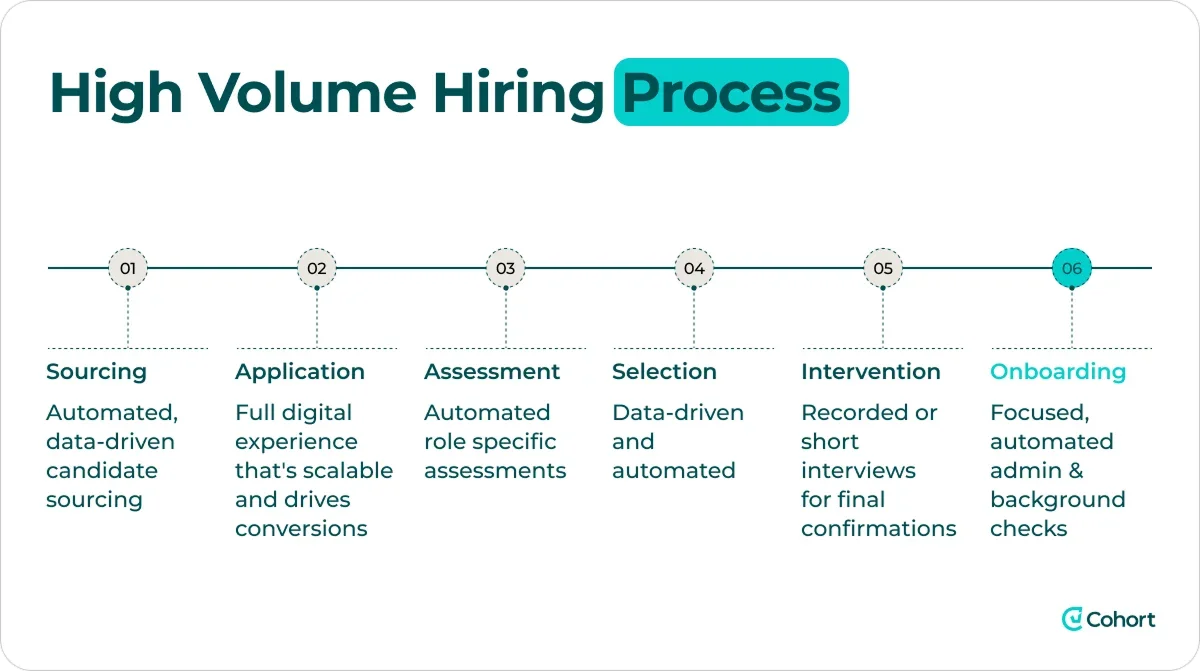
Common examples of high-volume hiring include:
- Retail: Recruiting seasonal staff for the holidays
- Call centers: Building large customer service teams
- Hospitality and tourism: Expanding staff during peak travel seasons
- Logistics and warehousing: Scaling up for high-demand periods
- Healthcare: Adding nurses, aides, and support staff
- Technology: Rapidly expanding engineering, IT, or customer success teams during growth or product launches
Top 5 high volume hiring challenges and how to overcome them
High-volume recruitment brings its own set of challenges that traditional hiring processes often don’t solve. Below, we’ll talk about give of the most common obstacles in high-volume hiring, and how you can successfully overcome each one.
Challenge 1: How to attract more qualified candidates
Attracting enough qualified applicants is often one of the toughest parts of high-volume hiring. Many organizations, particularly in industries like hospitality, retail, and leisure, struggle to fill seasonal or large-scale roles because the pool of skilled candidates is limited.
In fact, 60% of employers say they face a shortage of quality candidates for these positions, making it harder to build a strong and reliable talent pipeline.
✅ How to overcome it:
- Build a strong employer brand: Highlight your company’s culture, values, and benefits through your careers page, social media, and employee testimonials to attract candidates who resonate with your mission.
Studies show that companies with positive employer brands get twice as many applications as firms with negative reputations.
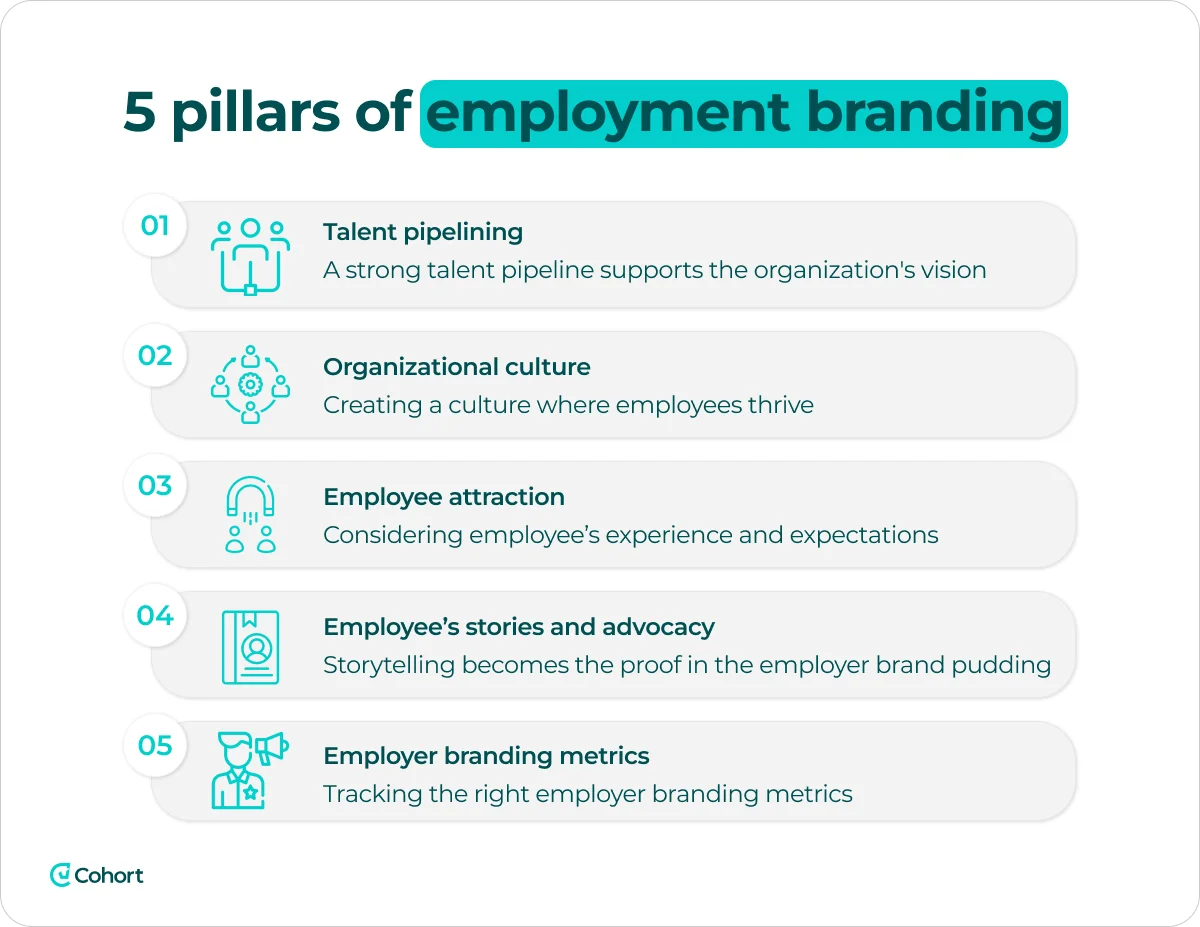
- Diversify your sourcing channels: Go beyond one job board by posting on multiple platforms, using employee referral programs, hosting hiring events, and reaching passive candidates through LinkedIn or industry forums.
- Create inclusive, targeted job postings: Write clear, engaging descriptions that outline required skills and benefits while using inclusive language to appeal to a broader audience.
Researches show that eliminating degree requirements for skills-based roles can lead to a 60% increase in applications.
- Stay flexible with requirements: Loosen non-essential criteria to give capable candidates who can learn on the job a fair chance, expanding your overall talent pool.
A Harvard Business School study found that 78% of business leaders believe over-filtering through strict criteria causes them to miss out on half or more of qualified middle-skills candidates.
🧠 Example: SEB
SEB, a Swedish financial services group, refreshed its employer brand to better connect with modern job seekers. By focusing on authenticity and employee storytelling, the bank positioned itself as a people-centered and purpose-driven workplace.
The results? Applications per open position increased by 61%, with noticeable improvements in candidate quality. Here’s what they did:
- Encouraged employees to share personal stories and experiences on social media to showcase SEB’s culture.
- Redefined its Employer Value Proposition (EVP) to highlight growth opportunities, purpose, and inclusion.
- Maintained consistent branding across career pages, campaigns, and digital platforms to strengthen recognition.
- Introduced employee advocacy and referral programs to amplify reach and engagement.
Challenge 2: Managing large volumes of job applications
High volume hiring can quickly lead to an overwhelming number of applications, sometimes hundreds or even thousands for a single role.
Without the right systems in place, manually reviewing each one is nearly impossible, causing delays, missed talent, and recruiter burnout.
✅ How to overcome it:
- Automate your screening: Use an Applicant Tracking System (ATS) or recruitment software to automatically filter unqualified candidates with knockout questions or keyword matching.
Using an ATS can shorten the hiring cycle by up to 60%, helping you focus only on the most promising applicants..

- Add quick skill checks: Include short assessments or questionnaires so only candidates who meet minimum criteria move forward, saving time on resume reviews and improving overall candidate quality.
- Streamline pre-screening: Use yes/no questions for must-have qualifications to instantly eliminate mismatched applicants before interviews begin.
- Keep it simple: Since forms with over 45 questions can cause up to a 90% drop-off rate, only ask the few most predictive ones.
- Simplify scheduling: Use automated interview scheduling tools so candidates can pick time slots without endless back-and-forth emails.
According to Phenom, 80% of organizations using AI tools to schedule interviews saved 36% of their time compared to manual scheduling, freeing recruiters to focus on high-value tasks.
- Scale with support: During peak hiring periods, consider RPO partners or volume-hiring specialists to expand your team’s capacity.
💡 Pro tip
Even with automation, it’s easy for great candidates to slip through when you’re drowning in applications. That’s where Cohort AI’s Eva the Evaluator steps in.
Eva runs asynchronous, role-specific interviews using AI prompts tuned to your job description and team culture, assessing both technical fit and behavioral alignment based on your success signals.
She handles resume reviews, coding challenges, and behavioral screening at scale, flagging red flags and surfacing only top performers, bringing consistency, objectivity, and cutting time-to-hire by up to 40%.
Challenge 3: Tight timelines
High-volume hiring often comes with urgent deadlines and intense pressure to fill roles fast. With the average time-to-fill sitting at around 44 days, traditional hiring processes can’t keep pace when hundreds of positions need to be filled in weeks, not months.
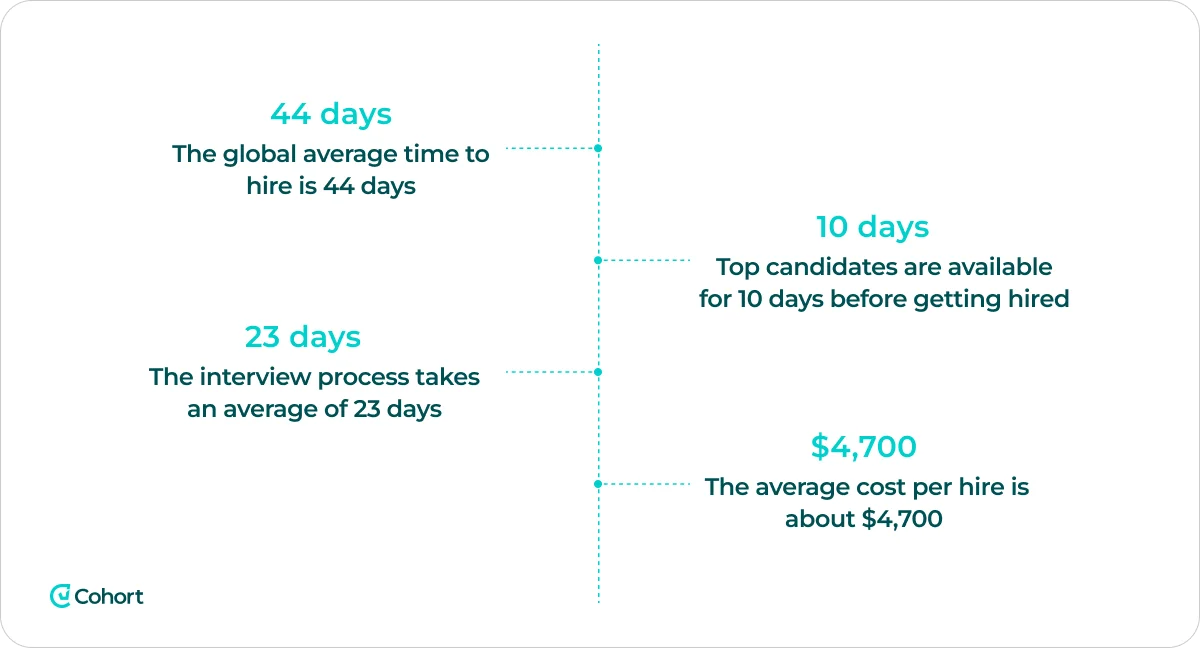
✅ How to overcome it:
- Plan ahead: Forecast hiring surges early and build a warm talent pool of past applicants or leads you can activate quickly when openings arise. In fact, companies with mature pipelines fill roles 50% faster than those starting from scratch.
- Re-engage past candidates: Reach out to previously qualified applicants who may now be ready for new opportunities.
- Streamline your process: Cut redundant approval steps and run tasks in parallel to accelerate hiring timelines.
- Host hiring events: Hold bulk hiring days to interview and make offers to multiple candidates in one session.
- Leverage technology: Use automation tools, video interviews, and real-time messaging to evaluate candidates efficiently.
Studies show that 52% of hiring teams now use recruiting chatbots and texting platforms to cut screening time and reduce cost-per-hire without sacrificing candidate experience.
🧠 Example: Global Business Services Company + RPO (475 hires in 3 weeks)
A technology-focused business services firm needed to hire 475 customer service agents fast during COVID to support a new client. Here is how they did it:
- Partnered with an RPO provider that built a dedicated team of sourcers, recruiters, and coordinators
- Used an ATS, programmatic job advertising, and email campaigns to target around 80,000 potential candidates
- Conducted over 1,100 interviews in just three weeks
🟢 Result: The company successfully achieved its 475-hire goal within three weeks, maintaining strong talent quality and reporting only 6–7% attrition during training.
Challenge 4: Maintaining the quality of hire during mass recruitment
When organizations hire at scale under time pressure, maintaining the quality of each hire becomes difficult as recruiters have limited time to properly assess candidates.
The urgency to fill roles often leads to accepting “good enough” applicants instead of truly qualified ones, resulting in lower quality-of-hire and increased turnover.

These poor hiring decisions can significantly impact performance and productivity, as a bad hire can reduce output by up to 40% and cost a business three to four times the employee’s annual salary.
✅ How to overcome it:
- Define quality clearly: Clearly outline what a “quality hire” means for each role, including the right mix of skills, experience, and behaviors, to ensure standards aren’t compromised for speed.
- Adopt skills-based hiring: Use objective assessments such as skills tests or simulations early in the process to verify competence. Research shows that companies using skills-based hiring see a 6.1× larger candidate pool.
- Standardize interviews: Implement structured interviews with consistent questions and scoring rubrics to fairly compare candidates, as research shows they are up to 70% more predictive of job success than unstructured ones.
- Leverage hiring data: Track how assessment results correlate with job performance to refine criteria and continuously improve hiring accuracy.
Challenge 5: Improving candidate experience
Maintaining a strong candidate experience is challenging in any hiring process, but it becomes exponentially harder during high-volume recruitment.
With hundreds of applicants, timely communication, transparency, and personalization often break down.
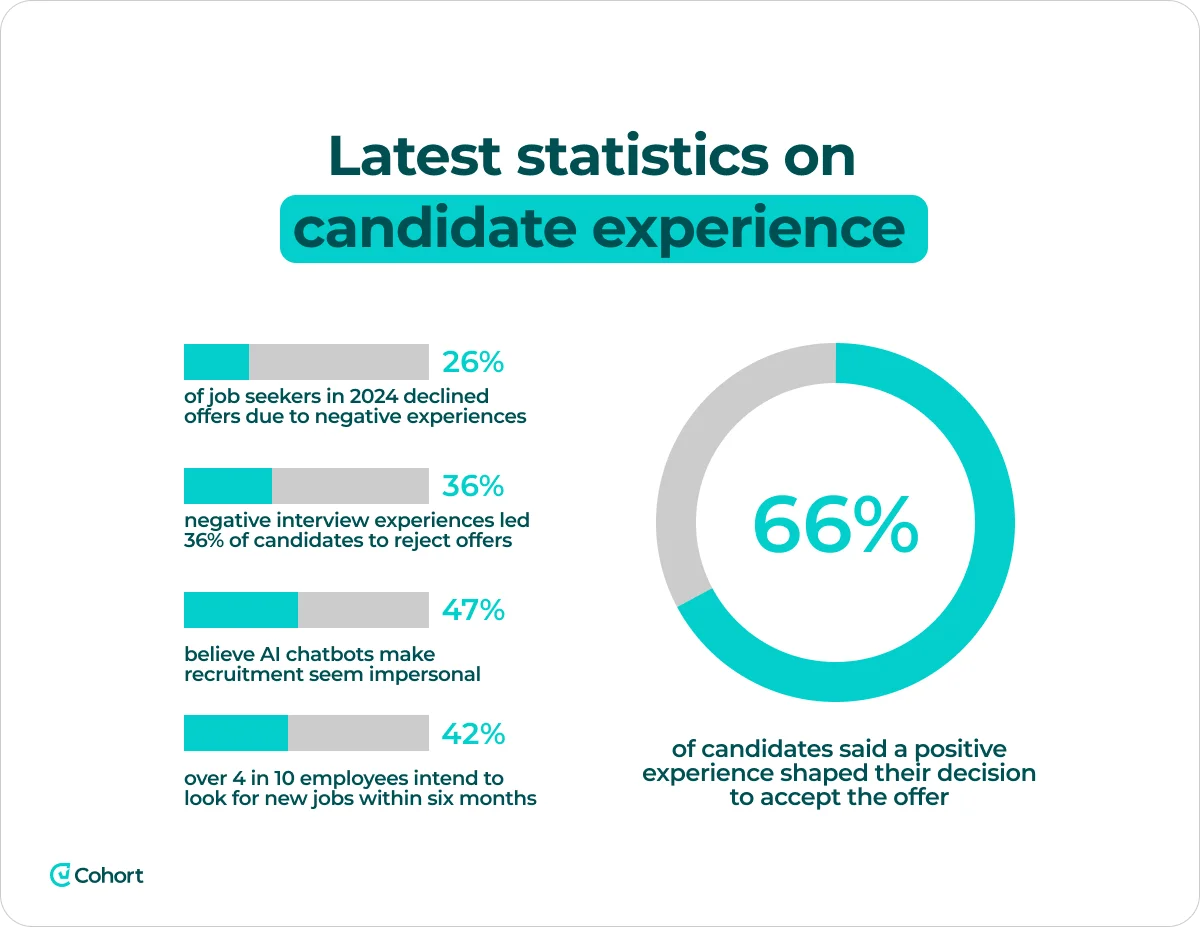
This leads to delays, impersonal messages, and disorganized interviews, ultimately damaging your employer brand, since 72% of candidates with a bad hiring experience share it with others.
✅ How to overcome it:
- Keep candidates informed: Clearly outline the hiring timeline, including the number of interview rounds and expected response times, and adhere to those deadlines.
- Communicate promptly: Send quick acknowledgments when applications are received and follow up after each stage, whether moving forward or not.
In fact, 81% of candidates say the single biggest way to improve their experience is if employers provided regular status updates.
- Use automation wisely: Leverage your ATS to send timely updates, but personalize messages so they feel respectful and human, not like generic form letters.
75% of recruiters use an ATS or tech-driven recruiting tools to improve communications and candidate experience.
- Offer constructive feedback: When possible, provide brief, thoughtful feedback to candidates who reach the interview stage.
This effort pays off as 94% of candidates want feedback after interviews, and those who receive it are four times more likely to consider applying again.
- Scale the experience: Use group Q&A webinars, career site chatbots, or self-service candidate portals to maintain transparency without sacrificing efficiency.
💡 Pro tip
Even the most well-intentioned recruiters struggle to maintain personalized communication at scale, especially when juggling hundreds of candidates.
With Cohort AI’s Pete the Prospector, you can automate outreach without losing the human touch. Pete acts as your personal outreach machine, sending AI-personalized messages based on each candidate’s activity, history, and role alignment.
He turns cold leads into warm conversations with natural, one-on-one communication that boosts engagement and reply rates, with zero manual follow-up.
Take your high-volume hiring to the next level with Cohort AI
High-volume hiring doesn’t have to mean long hours, rushed decisions, and overwhelmed recruiters. With the right technology, you can fill hundreds of roles quickly and still deliver a great candidate experience.
That's exactly where Cohort AI can help you!
Cohort AI redefines high-volume hiring by embedding generative AI and skills intelligence across every stage of the recruitment journey.
We help talent teams scale fast, stay consistent, and hire better without losing the human touch. Powered by SPEC, our system of AI agents that manage sourcing, outreach, screening, and engagement, Cohort AI acts like a 24/7 recruiting operations team, running quietly in the background to boost efficiency, reduce bias, and accelerate every part of the hiring process.
Here is what Cohort AI does:
🟢 Smarter talent sourcing – Discover high-potential candidates by focusing on real skills and achievements, not just resumes.
🟢 Automated screening and assessments – Instantly identify and evaluate top candidates with AI-powered, role-specific interviews and filters tuned to your success criteria.
🟢 Faster decisions – Cut time-to-hire by up to 40% through streamlined scheduling, skill-based evaluations, and real-time insights.
🟢 Personalized outreach and engagement – Send AI-tailored messages that reflect your brand voice, automate follow-ups, and keep candidates informed to reduce drop-offs.
🟢 Intelligent matching and consistent quality – Match candidates to roles based on skills, behaviors, and working styles, ensuring every hire aligns with your performance and culture standards.
Book a demo today and turn high-volume hiring into your competitive advantage.
FAQs:
1. How can I reduce candidate drop-off during high volume hiring?
Keep the application process short, clear, and mobile-friendly. Use one-click apply options, progress indicators, and transparent next steps to maintain engagement. Automated reminders and personalized follow-ups can also re-engage candidates who don’t complete their applications.
2. How can I forecast hiring volume needs in advance?
Analyze past hiring data, seasonal trends, and expected business growth to predict upcoming demand. Workforce analytics and AI tools can combine these insights to create more accurate forecasts, helping you plan resources and timelines effectively.
3. How can I reactivate past applicants or alumni for new roles?
Leverage your ATS or talent database to identify strong former candidates and reach out with personalized updates about new openings.



